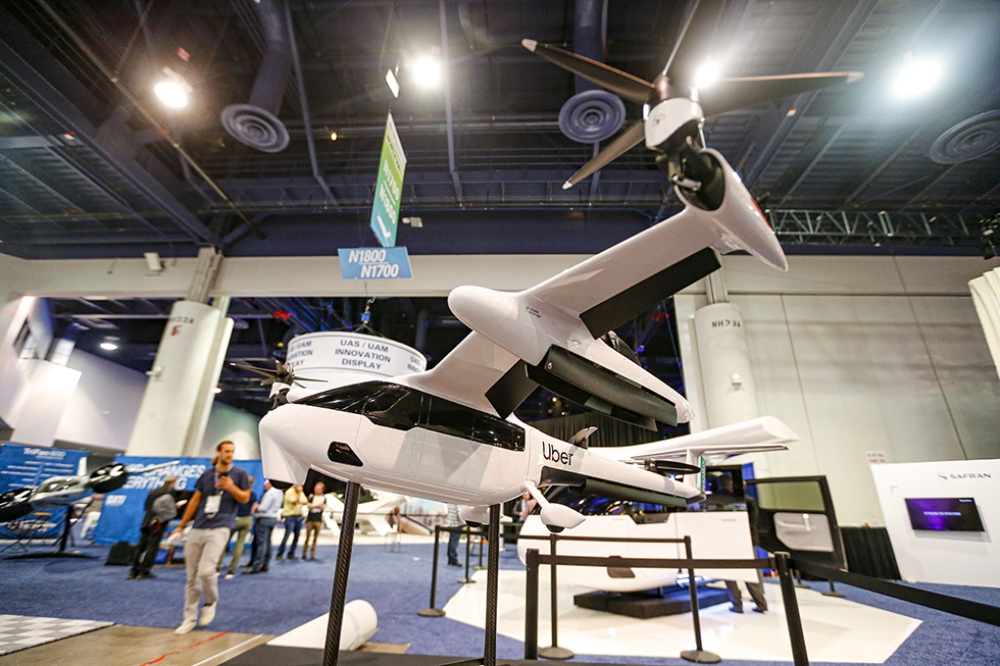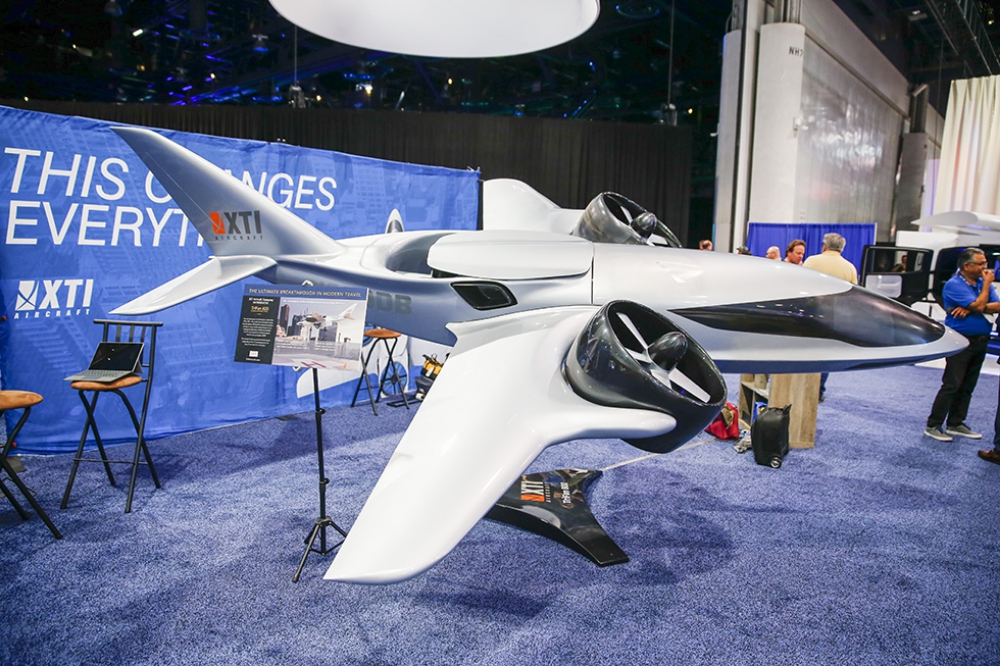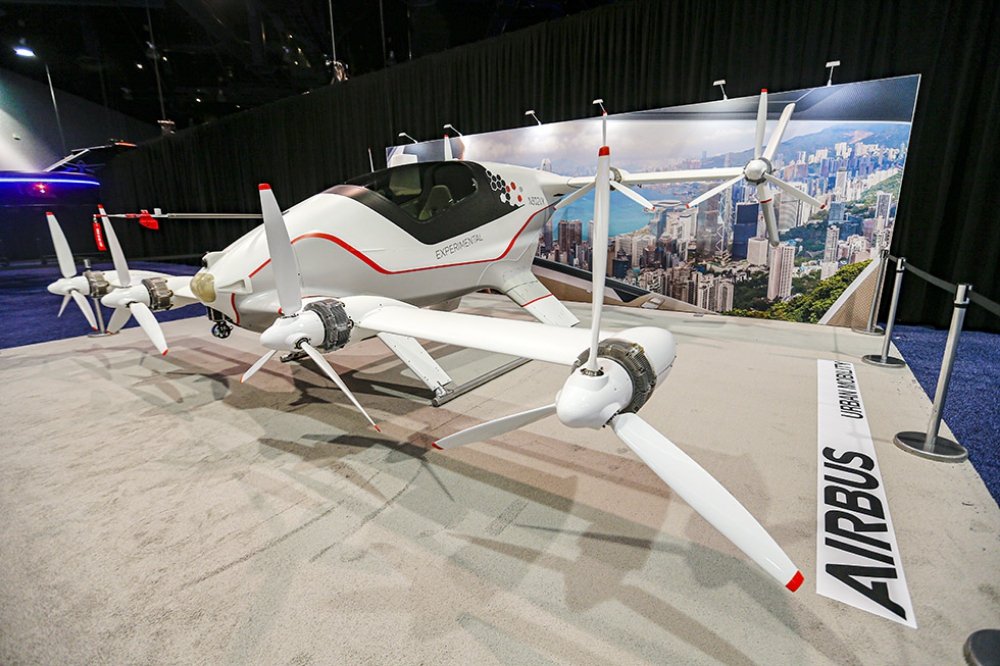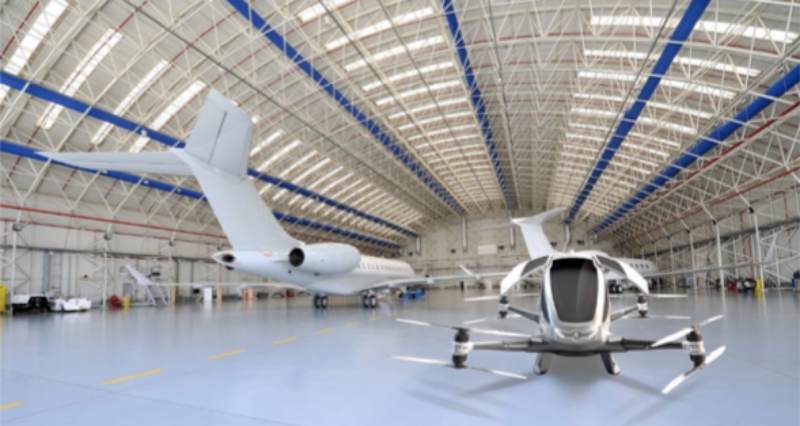NBAA Showcases Unmanned Air Taxi Innovations
The unmanned air taxi industry landed on the NBAA, with a host of vendors displaying mock-ups of designs they hope one day will be shuttling passengers throughout major cities.
The vendors are showcasing products at the “UAS/UAM Innovation Display” on the exhibition floor – part of a broad focus on unmanned aircraft systems (UAS) and urban air mobility (UAM) at this year’s show.
Over the next two days, experts will discuss the air taxi industry’s promise during panel discussions and keynote speeches.
Companies on hand include Uber Elevate (above), which has partnered with several air vehicle manufacturers to develop electric vertical takeoff and landing (eVTOL) aircraft capable of carrying four or five passengers.
“We are helping to create a whole new transportation opportunity for large metropolitan areas,” says Uber Elevate’s director of strategy Mark Moore.
Uber Elevate has developed a “common reference” of specifications for eVTOL vehicles that it believes will best serve the mission, and it has an aircraft mock-up at the show.
The aircraft must be quieter than the quietest helicopter and have “distributed technology”, meaning multiple electric motors, says Moore. The systems must also be free of “single part criticality”, meaning a single failure will not cause catastrophic problems.
The aircraft should have a 52nm range (96km), 3h endurance (stops included), be able recharge within 7min and have a speed of about 130kt (241km/h), according to Uber Elevate’s website.
The company anticipates first flight of an aircraft by 2022 and to certify five aircraft by 2023, with initial passenger flights expected to be conducted in Dallas, Los Angeles or Melbourne, Australia.
Safran has partnered with company to develop the cabin of Uber Elevate’s mock-up and is helping develop hybrid-electric technology for Bell’s Nexus air taxi concept. Bell is among about 10 companies designing aircraft to meet Uber Elevate’s specifications.
Others include Jaunt Air Mobility, which is displaying its “reduced rotor operating speed aircraft” – a four-passenger, one-pilot eVTOL that combines helicopter and fixed-wing characteristics. The aircraft takes off vertically using a main rotor and then transitions to forward flight, propelled by wing-integrated motors. During forward flight the main rotor’s rotation slows to a near standstill, Jaunt Air Mobility says.
Airbus’s technology incubator division A3 is showcasing Vahana (above), an all-electric, one-passenger VTOL demonstrator with eight motors integrated into tilting wings. Vahana has already completed 115 autonomous flights since its first flight in January 2018, and flight testing will wrap up in November, says A3 communications director Paige Wilson.
Airbus developed Vahana alongside another UAM demonstrator, CityAirbus, which expects to continue flight testing its vehicle until 2020.
Airbus intends to use insights from both projects to develop another autonomous, passenger-carrying eVTOL for certification next decade, says Wilson.
NBAA Report on Urban Air Mobility for Business Aviation
The National Business Aviation Association (NBAA) unveiled this week at its annual Business Aviation Convention & Exhibition (NBAA-BACE), a new report detailing the financial and economic business case for Urban Air Mobility (UAM) and its benefits for business aviation users. The report, titled Business Aviation Embraces Electric Flight, How Urban Air Mobility Creates Enterprise Value, was a joint undertaking of NBAA and NEXA Advisors, LLC.
This report is a component of a larger study released in August 2019 – Urban Air Mobility (UAM) Economics and Global Markets 2020-2040 – which was a joint undertaking with NBAA, Aviation Week Network, and other respected industry groups. The study analyzed 74 cities around the world, forecasting the financial and economic business case for UAM. To determine the ability of metro areas to capitalize on the potential of electric Vertical Takeoff and Landing vehicles (eVTOLs), the study examined each city’s needs with regards to UAM, including infrastructure, regulation, GDP, congestion, current transportation networks and dozens of other factors.
UAM is being proven in cities today, and is expected to become an increasingly important part of our transportation system in the next several years with the introduction of eVTOL aircraft. These new, battery-powered rotorcraft, which will utilize an array of emerging advanced technologies, are expected to be quieter and safer than current helicopters.
“These reports highlight the potential of eVTOLs to transform short-range air transportation, especially for those companies and individuals that use business aviation,” said NBAA Senior Vice President of Strategy and Innovation Mike Nichols, CAM, co-author of both the study and the white paper. “These companies are expected to be among the first eVTOL users because these vehicles will solve the ‘last mile’ or ‘door-to-door’ challenge by moving people quickly from a company office, to meetings in city centers that are near to existing heliports or newly constructed vertiports, or to outlying airports so passengers can depart on a business aircraft or scheduled airline flight.”
To determine the ability of metro areas to capitalize on the potential of eVTOLs, the study examined each city’s needs with regards to UAM, including infrastructure, regulation, GDP, congestion, current transportation networks and dozens of other factors.
“We have long known, and NEXA’s prior studies have proven, that business aviation creates significant enterprise value for many of the world’s top performing companies,” said Michael Dyment, NEXA Advisors’ Managing Partner and co-author. “We now know that the addition of eVTOL aircraft to business aviation operators will further increase their productivity and mobility. This translates into a positive impact on long-term enterprise value.”







Ingen kommentarer:
Legg inn en kommentar
Merk: Bare medlemmer av denne bloggen kan legge inn en kommentar.